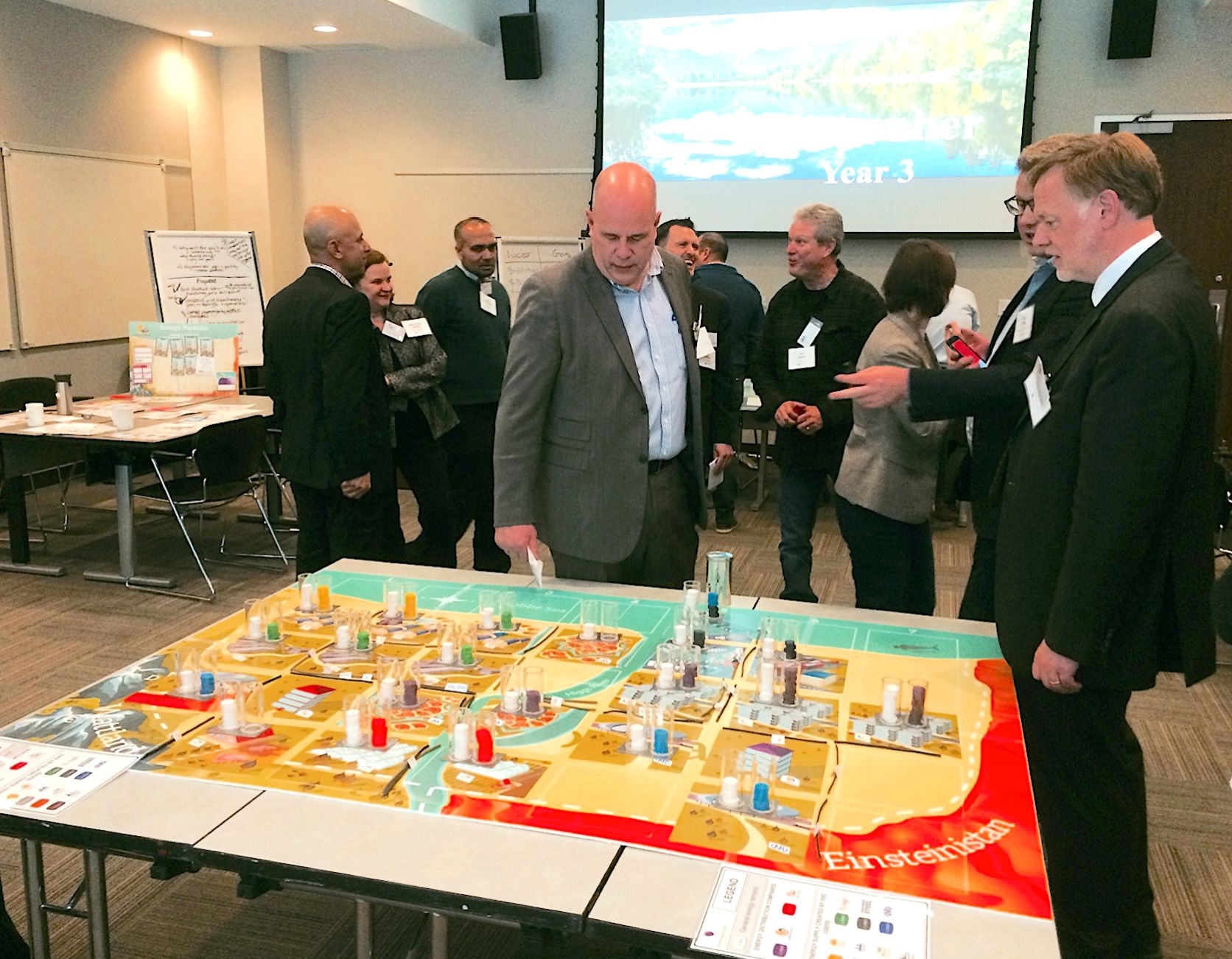Running an electric utility is a complex, serious business. So when 25 professionals gathered in a large meeting room in downtown Toronto to play a board game, some were understandably skeptical.
As the journalist in the room, I was among the skeptical. What could we -- a mix of utility executives, technology suppliers, government officials, industry regulators, and outside observers -- possibly get out of such a simple exercise?
Quite a bit, it turns out.
As the philosopher Plato is purported to have said, “You discover more about a person in an hour of play than in a year of conversation.”
Dutch utility Eneco commissioned the game, called Newtonian Shift, a few years ago as a way to help users think differently about the disruptive technologies and business models threatening its core business. More than half of its employees have since played the game, and Eneco is now recognized as one of the most innovative gas and electric utilities in Europe.
In North America, the Advanced Energy Center (AEC) at Toronto’s MaRS innovation hub and the Rocky Mountain Institute adapted Newtonian Shift for Canadian and U.S. audiences.
The game accelerates change in the energy sector by cramming 20 years into a half day of game play. Participants take on different roles in a fictional land called Newtonia, which is surrounded by neighboring countries Einsteinistan and Wattland.
The premise is simple: unsustainable growth in Newtonia has led to a dirty, outdated grid. The electric system has become unreliable, and Newtonia relies heavily on nuclear and fossil-fueled power imports from its neighbors. At the same time, the impacts of climate change have become more evident, and citizens are demanding action.
The leader of Newtonia then calls on all players to work together to build a more sustainable electricity system -- one that’s greener, more self-sufficient, and robust enough to reliably meet the needs of a growing population.
Oh, and there’s one overarching rule to encourage creativity in planning: “Other than that which is not permitted is allowed.”
Ron Dizy, managing director of AEC, said utilities have been told for years that an existential threat -- the so-called utility death spiral -- will force them to transform their businesses if they hope to survive.
“Technology is changing fast, and the cost of alternatives is coming down,” Dizy said. “Industry executives probably go to a session a week where they hear that same message, but when you ask them what they’re doing about it, the answer, usually, is 'Not much.'”
PowerPoint presentations chock-full of data and graphs may tell part of the story, but the message isn’t being internalized, Dizy said. He suspects many executives and their employees are becoming desensitized to the risk and are starting to tune out. “By running the game, our attempt is to give people a jolt,” he said. “We’ve got to find another way of getting the message through to them.”
Let the game begin
Each of us in the Toronto session had to take on a certain role. I became chief executive at Western Energy, one of two utilities in Newtonia, and had staff to help me with innovation, billing, accounts and grid maintenance.
There was a capital called Voltcity, whose mayor had to make sure the lights were kept on for its growing population. There was an energy-hungry steel maker, railway operator, and farming community, as well as an innovation cluster led by the Sun Society and Boogle, Newtonia’s equivalent of Google. We also had a bank we could turn to for loans.
Immediately, Newtonia fell into complete chaos. A major outage on the main grid left Voltcity without power, and with limited financial resources, we had to scramble to fix it. Do we invest in a Band-Aid solution or an advanced grid with clean, distributed generation? We ended up taking the quickest and cheapest route, which left us vulnerable in later rounds.
Industry, meanwhile, quickly grew impatient. Seeking a more reliable power source, the steel and railway companies partnered to build a more advanced grid that attempted to bypass our incumbent utility. Boogle and Sun Society built wind and solar parks to supply Voltcity and the agricultural sector. From the start, my utility didn’t even think about investing in conservation efforts. Our posture was defensive as we scrambled to meet basic customer demands. Rather than embracing collaboration to better achieve common societal goals, we tried -- and failed -- to do it all on our own.

Rounds two and three were only marginally better. We started to collaborate more with other players, and this brought mutual benefits, but we also found ourselves playing a game of catch-up.
Every time we felt like we were stabilizing the business, something unexpected would happen -- another major outage, or a new government mandate that pulled us in another direction. At one point, a nuclear meltdown in Einsteinistan cut off a major source of imported power, and this was followed by a politically motivated disruption in natural-gas supply from Wattland.
As a fictional utility CEO, I came to appreciate the difficulty of trying to put out multiple fires while balancing so many competing demands. Even the real-world executives in the room felt the pressure.
“Because of how much the time was collapsed, it really puts you under a lot of stress, and makes you think fast on your feet,” said Michael Angemeer, president and CEO of Veridian, a mid-sized electric utility owned by four municipalities in Ontario.
Atul Mahajan, president and CEO of Oshawa Power and Utilities Corporation, which operates east of Toronto, described the game as a high-level demonstration of how industry change can arrive fast and hit hard.
“I consider myself open-minded and an early adopter of change, but it was very telling that as we played the game, we started falling into a trap -- the trap of being conditioned to think within a box,” Mahajan said. “I kept looking for the regulator to step in and help.”
Turning to government for rules that protect a utility’s monopoly business is often the industry’s default position.
It can be observed in Nevada, where the state’s public utility commission slashed net metering payments to residential solar generators, while substantially raising fixed fees that cover NV Energy’s grid maintenance costs. NV Energy executives have been outspoken about their disdain for retail net metering.
Several other states are also pushing back against distributed solar, citing it as a threat to their business model. States like California may be more supportive of new technologies and service strategies, but they still largely shift their business risks onto the rate base.
It’s a reckless trajectory over the long term, said Dizy. As the costs of solar and energy storage fall, it will become easier for households, businesses and entire communities to disconnect from the grid. Raising grid maintenance fees for all and imposing extra fees on those who embrace rooftop solar will, over time, only anger more customers and fuel their desire to reduce their reliance on the centralized system.
“They can’t survive in a pure rate-based world forever, because customers will eventually migrate to others who offer a broader range of services,” said Dizy.
A wake-up call
In Canada, cable and internet giant Rogers Communications, which participated in a Newtonian Shift game session late last year, sees energy services as a major component of its “connected home” strategy. Telstra, a major telecom firm in Australia, has already announced plans to make solar-plus-storage a service option for millions of its customers. In doing so, it is taking a business risk that local and regional electric utilities have typically found difficult to shoulder.
Some are trying. Oshawa Power and nearby PowerStream, Ontario’s second-largest electric utility, have both launched solar-plus-storage pilot projects that have seen dozens of homes in the Canadian province equipped with the technology combo.
PowerStream, for example, aims to network these residential systems together like computers scattered around an office, allowing it to remotely operate what is effectively a zero-emission virtual power plant. The utility owns, maintains and operates the solar-plus-storage systems, treating them like any other infrastructure investment. The customer, in exchange, gets a break on power bills by handing over some system control that allows the utility to operate the grid more efficiently.
Mahajan at Oshawa Power said both utilities and regulators have to think differently about what constitutes infrastructure spending as the industry transitions.
“Instead of building a substation for a billion dollars, the question is whether you can achieve the same thing with modern technology that benefits everybody,” he said. “If we keep using the same excuses we’ve used in the past for not doing something, progress will never happen.”
“Fortune ultimately favors the brave," added Mahajan.
That may hold true in some cases, but it wasn’t David Crane’s experience while at NRG Energy, one of America’s largest independent power producers. Crane tried to push through his vision of becoming a major supplier of distributed renewable energy, but investors focused on short-term returns took issue with Crane’s long-term vision. Crane was fired in December.
“Energy incumbents remain a wellspring of potent opposition to climate advocates in the fight against climate change,” Crane wrote in a column shortly after his dismissal from NRG. “Until we find a way to enable the CEOs of these companies to change their business strategy without fear of reprisal, we can count on their dogged resistance to society's transformation to a clean-energy economy.”
It’s the kind of resistance Mahajan faces regularly, from both his board of directors and the executives who report to him.
“There’s a lot of discomfort in making that change happen,” he said. “I have a lot of lashes on my back to prove it, and it hurts, because it comes from people sitting around me at the executive table. They simply don’t believe the strategic direction I’m proposing makes sense.”
Mahajan said Crane’s firing will only create a chill for others in the industry trying to push through similar change. “What happened to Crane certainly doesn’t help.”
It also suggests that Newtonian Shift needs to be played by a broader group of people -- for example, board members and investors -- who don’t fully understand the challenges that electric utilities are facing, or the opportunities in front of them.



